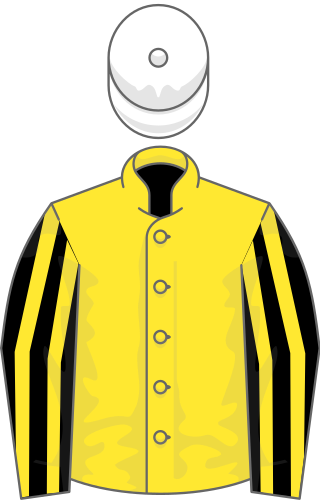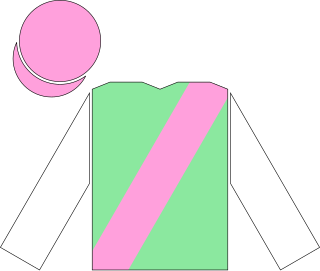Related Research Articles

Nearco was an Italian-bred Thoroughbred racehorse described by Thoroughbred Heritage as "one of the greatest racehorses of the Twentieth Century" and "one of the most important sires of the century." He was unbeaten, winning 14 races at distances from 1000m to 3000m, including the Derby Italiano and Grand Prix de Paris. He was then sold for a record amount to Martin H. Benson and stood stud in England, where he became the patriarch of several of the most dominant sire lines in Thoroughbred history.
Bald Eagle (1955–1977) was an American-bred Thoroughbred Eclipse Award-winning racehorse who competed successfully in both the United Kingdom and the United States. He won the Washington, D.C. International Stakes twice, in 1959 and 1960.
Ballymoss (1954–1979) was an Irish Thoroughbred racehorse. In a racing career that lasted from 1956 until November 1958, he ran seventeen times and won eight races. In 1957, he became the first horse trained in Ireland to win the St Leger Stakes. The following season, he was Europe's leading middle-distance horse, winning the King George VI & Queen Elizabeth Stakes and the Prix de l'Arc de Triomphe.

Colorado (1923–1929) was a British Thoroughbred racehorse and sire. He won the 2000 Guineas in 1926 and the Eclipse Stakes in 1927. He was also noted for his rivalry with the Derby winner Coronach whom he defeated on three of their four meetings.

Tulyar (1949–1972) was an Irish bred, British-trained Thoroughbred racehorse and sire. He won The Derby, the St Leger Stakes, the King George VI & Queen Elizabeth Stakes, the Ormonde Stakes and the Eclipse Stakes setting a record for a single season's earnings in England. He stood at stud in Ireland and America, but failed to live up to expectations as a sire.
Career Boy was an American Champion Thoroughbred racehorse.
Lemhi Gold was an American Thoroughbred Champion racehorse. In 1982, he was voted American Champion Older Male Horse at the Eclipse Awards after a season in which he won the Marlboro Cup and the Jockey Club Gold Cup.

User Friendly is a European Champion Thoroughbred racehorse.
Drum Taps was an American-bred Thoroughbred racehorse. He was a noted stayer, showing his best form over distances in excess of two miles, but was also successful over shorter distances. He won England's most important staying race, the Ascot Gold Cup in 1992 and 1993. In 1992 he was named European Champion Stayer of 1992 at the Cartier Racing Awards. He raced in seven countries in a career which lasted from 1989 to 1993.
Somnus is a retired British champion Thoroughbred racehorse. One of the best European two-year-olds in 2002, he developed into a leading sprinter the following year when he won the Group One Haydock Sprint Cup. As a four-year-old he won two more Group One races in France- the Prix Maurice de Gheest (2004) and the Prix de la Forêt- and was named European Champion Sprinter at the Cartier Racing Awards. He continued racing until being retired in 2008 at the age of eight, having won ten of his forty-three races. Unlike many sprinters, Somnus was not a pure "speed horse" and ran only once, unsuccessfully, at five furlongs: all his victories came over six or seven furlongs.
Kalaglow (1978–1994) was an Irish-bred, British-trained Thoroughbred race horse. In a career which lasted from August 1980 until October 1982 he ran fourteen times and won ten races. He is most notable for his performances in 1982 when he "lit up the summer" with a series of victories including the Eclipse Stakes and King George VI and Queen Elizabeth Stakes.

Toulon (1988–1998), was a Thoroughbred racehorse and sire who was bred in Britain and trained in France. In a career which lasted from October 1990 until October 1992, he ran eleven times and won four races. He recorded his most important success when winning the Classic St. Leger Stakes as a three-year-old in 1990, the same year in which he won the Chester Vase and the Prix Maurice de Nieuil as well as finishing fourth in the Prix de l'Arc de Triomphe. In the following season he failed to win in four races in Europe and had limited success when racing in California in 1993. He was then retired to stud, where he proved to be a successful sire of National Hunt horses.
Snurge, was an Irish-bred British-trained Thoroughbred racehorse and sire. In a career which lasted from September 1989 until September 1994, he ran thirty-four times and won seven races. He recorded his most important success when winning the Classic St. Leger Stakes as a three-year-old maiden in 1990. In the following seasons he won major races in France, Italy and Canada, before retiring as a seven-year-old. At the time of his retirement he held the record for prize money won by a European-trained horse, although the precise total of his earnings was difficult to determine because of the number of different currencies involved.
Trophonius was a British Thoroughbred racehorse and sire and best known for winning the classic 2000 Guineas in 1811. Trophonius won his first three races at Newmarket Racecourse in the spring of 1811, including the Guineas and the Newmarket Stakes on the following afternoon, but ran disappointingly when favourite for The Derby. He never recovered his best form and was beaten in his remaining seven races. Shortly after his retirement he was sold and exported to stand as a breeding stallion in Russia.
Shady Heights was a British Thoroughbred racehorse. In four seasons on the racecourse he competed in Britain, Ireland, France, Germany, Japan and the United States, winning seven of his twenty-nine contests.
Sandwich was a British Thoroughbred racehorse that won the classic St Leger Stakes at Doncaster Racecourse in 1931, for owner Earl of Rosebery. By 1931, Archibald Primrose, 5th Earl of Rosebery had died, making this a win for his son, Harry Primrose, 6th Earl of Rosebery. Sandwich was a half-brother to Manna, winner of the 1925 Epsom Derby, and as well as his 1931 St Leger success also won the Chester Vase and King Edward VII Stakes.
Zieten was an American-bred Thoroughbred racehorse and sire. Trained in France as a juvenile he was unbeaten in four races including the Prix La Flèche, Prix d'Arenberg and Middle Park Stakes. In the following year he took his unbeaten run to five in the Prix de Fontainebleau but was beaten in six subsequent races. As a four-year-old he raced in Japan and England and recorded a final big win in the Challenge Stakes. He was then retired to stud and had some success as a breeding stallion.

Strategic Choice was an American-bred, British-trained Thoroughbred racehorse and stallion. In a racing career which lasted from April 1994 until July 2000 he competed in nine different countries – Britain, France, Italy, Germany, Ireland, Japan, Turkey, Canada and Hong Kong – and won six of his thirty-four races. Unraced as a two-year-old he won the John Porter Stakes and Irish St. Leger at four, the Gran Premio di Milano and Grand Prix de Deauville at five and the Bosphorus Trophy at six. He was also placed in the King George VI and Queen Elizabeth Stakes, Gran Premio del Jockey Club, Yorkshire Cup and St Simon Stakes. After his retirement from racing he had some success as a sire of National Hunt racing.
Oscar Schindler was an Irish Thoroughbred racehorse and stallion best known for being the second horse to win two runnings of the Irish St. Leger. In a racing career which lasted from October 1994 until November 1997 he competed in five different countries and won five of his twenty starts.
Le Ksar was a French Thoroughbred racehorse and sire. Unraced as a two-year-old, he finished second in the Prix Juigné on his racecourse debut and then recorded an emphatic upset victory in the 2000 Guineas. He finished second in the Poule d'Essai des Poulains but ran poorly in the Epsom Derby and never reproduced his best form in subsequent races. He stood as a breeding stallion in England and Argentina but made no impact as a sire of winners.
References
- ↑ "Mashaallah pedigree". Racing Post. 2011-06-02. Retrieved 2011-09-12.
- ↑ "Homespun Offspring". Pedigreequery.com. Retrieved 2011-09-12.
- ↑ "Mashaallah Horse Pedigree". Pedigreequery.com. Retrieved 2011-09-12.
- ↑ "Singapore Airlines Manchester Handicap". Racing Post. Retrieved 2011-09-12.
- ↑ "Prix de la Porte de Madrid". Racing Post. Retrieved 2011-09-12.
- ↑ "Gran Premio di Milano". Racing Post. Retrieved 2011-09-12.
- ↑ "Grosser Preis von Baden". Racing Post. Retrieved 2011-09-12.
- ↑ "Irish St. Leger". Racing Post. Retrieved 2011-09-12.
- ↑ "Bramham Moor Conditions Stakes". Racing Post. Retrieved 2011-09-12.
- ↑ "Prix Royal Oak". Racing Post. Retrieved 2011-09-12.
- ↑ "Hollywood Turf Cup". Racing Post. Retrieved 2011-09-12.
- ↑ "Mashaallah race record". Racing Post. 2011-06-02. Retrieved 2011-09-12.
- ↑ "Haras Carioca - CHILE". Dom1.elturf.com. Archived from the original on 2012-04-02. Retrieved 2011-09-12.
- ↑ "Mashaallah Offspring". Pedigreequery.com. Retrieved 2011-09-12.